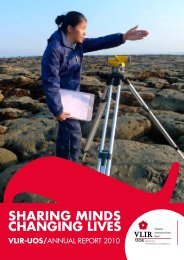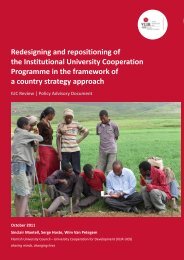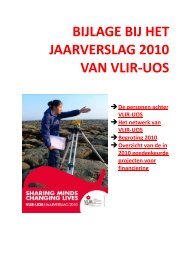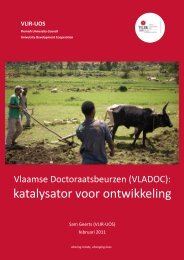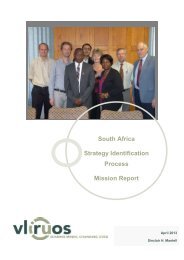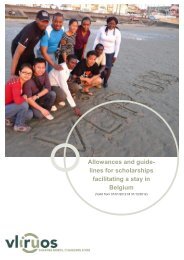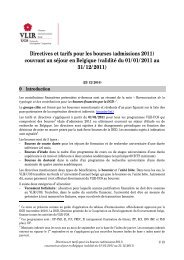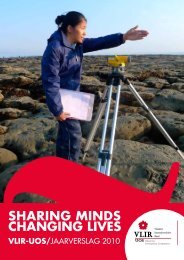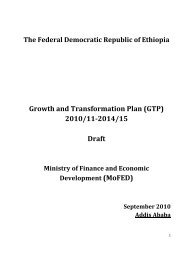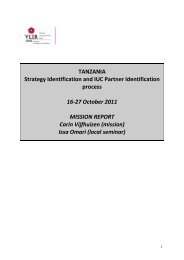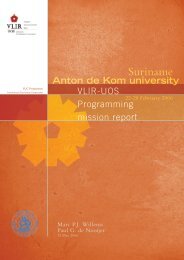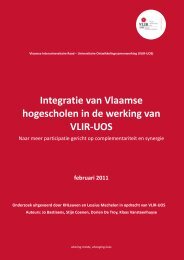Education Sector Development Program - VLIR-UOS
Education Sector Development Program - VLIR-UOS
Education Sector Development Program - VLIR-UOS
Create successful ePaper yourself
Turn your PDF publications into a flip-book with our unique Google optimized e-Paper software.
<strong>Education</strong> <strong>Sector</strong> <strong>Development</strong> <strong>Program</strong> IV<br />
be reviewed to ensure a similar focus, based on<br />
the implementation of a relevant framework and<br />
guidelines.<br />
The curriculum revision will ensure that<br />
Population and Family Life <strong>Education</strong> (POP/<br />
FLE) be addressed. Issues such as the effects<br />
of teenage pregnancy, female genital mutilation<br />
(FGM), early marriage, sexually transmitted<br />
infections, abduction and other harmful<br />
traditional practices (HTP) that affect retention,<br />
increase dropout and repetition rates and widen<br />
the gender gap will be included in subjects such<br />
as Civics, Languages, Biology, etc. of the teacher<br />
training curricula.<br />
School improvement <strong>Program</strong><br />
For schools to experience sustained improvement,<br />
it is probably necessary that school staff and their<br />
surrounding communities take responsibility for<br />
their own improvement. But for schools to be<br />
able to take such improvement actions they need<br />
to be supported by the experts and supervisors in<br />
the administration and they need to receive some<br />
basic funds.<br />
The strategies on which ESDP IV will focus<br />
will therefore consist of the following. Firstly,<br />
guidelines and instruments on how to prepare<br />
a school improvement plan will be prepared<br />
and distributed to schools. In each woreda and<br />
regional bureau a few experts will be trained<br />
so that they can give the necessary support to<br />
schools and communities. Training will also be<br />
extended to stakeholders at the school level, in<br />
particular principals, teachers and members of<br />
parents’ associations and school management<br />
committees. As a result, school leadership and<br />
management and competency of teachers at all<br />
levels will be improved.<br />
For schools to be able to implement their<br />
strategic plans, most will need to receive some<br />
financial resources. Under GEQIP therefore, a<br />
“school grants” program has started which will<br />
be an integral part of ESDP IV. The disbursement<br />
of school grants will be accompanied by a public<br />
information campaign about the purpose and<br />
use of school grants to be dedicated to education<br />
quality improvement activities like teaching aids,<br />
science & math laboratories, libraries established<br />
in line with the revised curriculum, and provision<br />
of ICT, etc. Training will be organized for school<br />
staff and for staff in regional and woreda offices<br />
in some basic financial management and in the<br />
use of the school grant.<br />
Continuous assessment accompanied with action<br />
research, strengthening co-curricular activities<br />
and school-parent-community relations as well<br />
as scaling up best practices in SIP will also be<br />
strategies of maximizing student achievement in<br />
ESDP IV.<br />
Information Communications Technology<br />
The government will continue the expansion<br />
of ICT use in education in order to improve the<br />
quality of teaching and learning. For such quality<br />
improvement to occur, it is necessary to go<br />
beyond the provision of more ICT infrastructure.<br />
Strategies under ESDP IV will therefore cover<br />
three main areas to improve the linkage between<br />
ICT and quality.<br />
Firstly, it is the intention to develop and implement<br />
a technology responsive ICT national curriculum<br />
for primary, secondary and higher education as<br />
well as for other educational institutions. New TV<br />
programs will be prepared in line with the revised<br />
curriculum. A second area of great importance<br />
concerns teacher training and awarenessraising.<br />
Efforts will be continued to reinforce<br />
the skills of teachers to use ICT efficiently and a<br />
program will be developed to train a critical mass<br />
of computer literacy teachers.<br />
Thirdly, further work will need to be done to<br />
expand access of schools to ICT infrastructure to<br />
allow more students and teachers to benefit from<br />
the more widely available global information<br />
sources. This will help the development of an<br />
e-learning culture among students and teachers.<br />
In this regard, the national school net project<br />
needs to be further expanded. At the same time,<br />
high capacity content servers will be installed<br />
in more secondary schools. The educational<br />
television programs will be broadcasted through<br />
12 satellite channels. Problems of maintenance<br />
may occur and therefore the technical capacity in<br />
maintenance of ICT equipment at regional level<br />
will be expanded.<br />
Quality of school infrastructure and<br />
facilities<br />
Few data are available on the quality of school<br />
infrastructure and facilities. A first step in an<br />
improvement strategy therefore consists of<br />
collecting more comprehensive data on this<br />
issue. This data collection needs to be guided<br />
by minimum standards on the quality of school<br />
infrastructure and on the availability and quality<br />
of facilities. This will allow a comparison between<br />
and within regions and a better selection of the<br />
schools where repairs, upgrading or construction<br />
of facilities are most needed.<br />
The improvement of facilities should focus<br />
on those which have the greatest impact on<br />
improving access, equity and quality, such as the<br />
provision of latrines for girls in primary schools<br />
and libraries in secondary schools.<br />
25



